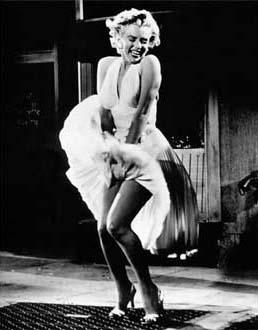AFI’s Tribute to Marilyn Monroe, 50 Years After Her Death
By • August 20, 2012 0 1622

It’s August, and in the course of a hot summer month 50 years ago, screen icon, sex symbol, tragic muse to many a play and novel, actress Marilyn Monroe died of an overdose, in somewhat mysterious and still speculated about circumstances. She was only 36 years old. Her ex-husband American baseball legend Joe DiMaggio for years afterwards brought flowers to her tomb in Hollywood.
The American Film Institute is commemorating the 50th anniversary of her passing with a special series of some of Monroe’s finest films through Sept. 16 at its Theatre and Culture Center in Silver Spring.
The selected films show off the character of Monroe’s gifts, talents, and charisma and hold a key to understanding the hold she has on American imagination. Some of the films may date in content and style, but her gifts continue to shine through.
Monroe was not the first sex symbol brought forth by films, nor the last. She was not America’s sweetheart or the most beautiful woman ever to grace the silver screen, but she was a kind of dream that men—and women, those that dream of fame, glory, stardom and celebrityhood and its contents and discontents—still dream. For men of pretty much all ages of that time—young boys, cads, millionaires, intellectuals and muscle boys, even a president—she was a kind of reality show. She had a kind of welcoming openness that made you think about idle prospects if only you might be sitting at the same lunch counter with her.
Her life was also something of a cautionary tale of the price of fame, how debilitating and crushing a burden it could become as it was for her. She married an American sports legend and an American intellectual and literary legend, which speaks to her need for adoration and intellectual respect. Neither worked out: Joe DiMaggio’s departure being brief, having mistakenly assumed that she could turn Marilyn into a good Italian boy’s housewife. The marriage with Arthur Miller lasted longer, and resulted in two offspring for Miller, the screenplay for “The Misfits” and the classic play “After the Fall.”
She was quotable, and stories and rumors surrounded her like a light mink coat. “What do you have on when you’re in bed?” she was asked. “The radio,” she replied. And, having entertained the troops in South Korea amid huge adulation, she told her husband the New York Yankees’ Joltin’ Joe, “You’ve never heard such cheering.” He replied: “Yes, I have.”
Among the AFI’s selected films: “Monkey Business,” a black-and-white dizzy comedy with Cary Grant, with whom she held her own in the banter and laughs department; “Gentlemen Prefer Blondes,” in which she was the gold-digginest of blondes alongside busty brunette Jane Russell, singing “Diamonds Are a Girls Best Friend”; “The Prince and the Showgirl,” in which she was an appealing showgirl to Laurence Olivier’s rather dour prince; “How to Marry a Millionaire,” standing and wiggling tall next to Betty Grable and Lauren Bacall; a classic and beautiful and affecting performance as a showgirl courted by a cowboy in “Bus Stop”; the dark thriller “Clash By Night”; the sharp, tightly written “The Asphalt Jungle,” in which she had a small but, as always, memorable part as a gun moll; and the unforgettable and by-now classic “The Misfits”.
Legends have grown up around this drama about a woman in Reno for a divorce, hooking up with modern cowboys Clark Gable and Montgomery Clift under the direction of John Huston.
By all accounts it was a tough shoot: Marilyn popping pills and late all-the-time; Clift not much better in his declining years; Gable dying of a heart attack soon after shooting’s end; Miller battling with Marilyn and Huston. It was perhaps Gable’s finest film, and he said as much after seeing rushes. The movie haunts and all the people are haunting and haunted by it. Another writer and I heard Eli Wallach, who played Gable’s buddy talk about it years ago over a lunch interview at Georgetown’s departed classic saloon and restaurant, Nathan’s. Wallach resurrected the film and Monroe before our eyes as if it were yesterday.
It was yesterday, 50 years ago.
For information on the Monroe movie commemoration, visit the AFI website.

